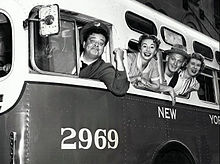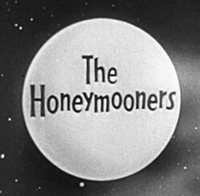The Honeymooners

The Honeymooners: The $99,000 Answer

Ralph goes on a game show to win $99,000.
Title screen
The Honeymooners is an American sitcom, based on a recurring 1951–55 sketch of the same name. It originally aired on the DuMont network’s Cavalcade of Stars and subsequently on the CBS network’s The Jackie Gleason Show hosted by Jackie Gleason, and filmed before a live audience. It debuted as a half-hour series on October 1, 1955. Although initially a ratings success—becoming the #2 show in the United States its first season—it faced stiff competition from The Perry Como Show, and eventually dropped to #19, ending its production after only 39 episodes (now referred to as the “Classic 39”). The final episode of The Honeymooners aired on September 22, 1956. Gleason went on to revive The Honeymooners as sketches and hour-long specials off and on through 1978. The Honeymooners was one of the first U.S. television shows to portray working-class married couples in a grittier non-idyllic manner living in a run down Brooklyn apartment complex.
Cast and characters
 The show’s cast in 1955 as it premiered on CBS.
The show’s cast in 1955 as it premiered on CBS.
The majority of The Honeymooners focused on its four principal characters on fixed sets within a Brooklyn apartment building. Although various secondary characters made multiple appearances and occasional exterior shots were incorporated during editing, virtually all action and dialog was “on stage” inside the normal backdrop.
Played by Jackie Gleason—a bus driver for the fictional Gotham Bus Company. He is never seen driving a bus (except in publicity photos), but is often shown at the bus depot. Ralph is frustrated by his lack of success, and often develops get-rich-quick schemes. Ralph is very short tempered, frequently resorting to bellowing, insults and hollow threats. Well hidden beneath the many layers of bluster however, is a soft-hearted man who loves his wife and is devoted to his best pal, Ed Norton. Ralph Kramden is the inspiration for the animated character Fred Flintstone.
Alice (née Alice Gibson), played in the first seven episodes by Pert Kelton and by Audrey Meadows throughout the “classic 39”, is Ralph’s patient but sharp-tongued wife of roughly 15 years. She often finds herself bearing the brunt of Ralph’s insults, which she returns with biting sarcasm. She is levelheaded, in contrast to Ralph’s pattern of inventing various schemes to enhance his wealth or his pride; in each case, she sees the current one’s unworkability, but he becomes angry and ignores her advice (and by the end of the episode, her misgivings are almost always proven to have been well-founded). She has grown accustomed to his empty threats: “One of these days… POW!!! Right in the kisser!” or “BANG, ZOOM! Straight to the moon!”, to which she usually replies, “Ahhh, shut up!”. She studied to be a secretary before her marriage, and works briefly in that capacity when Ralph is laid off. Wilma Flintstone is based on Alice Kramden.
Another foil for Ralph is Alice’s mother, who is even sharper-tongued than her daughter. She despises Ralph as a bad provider. Alice’s father is occasionally mentioned but never seen. Alice’s sister, Agnes, appeared in one episode (Ralph jeopardizes his newlywed sister-in-law’s marriage after giving some bad advice to the groom, but all works out in the end.) Ralph and Alice lived with her mother for six years after getting married before they got their own apartment. Ralph’s mother is rarely mentioned, but appears in one episode. Ralph’s father is only mentioned in one episode (Young Man With a Horn) as having given Ralph a cornet he learned to play as a boy and insists on keeping when Alice suggests it be thrown away. In a 1967 revival, Ralph refers to Alice (played by Sheila MacRae 1966–70 and once more in 1973) being 1 of 12 children and her father never working.
The Honeymooners was originally a sketch on the DuMont Network’s “Cavalcade of Stars”, with the role of Alice played by Pert Kelton. When his contract with DuMont expired, Jackie Gleason moved to the CBS network where he had “The Jackie Gleason Show”, and the role went to Audrey Meadows; Pert Kelton’s husband had been blacklisted during the McCarthy hearings, affecting her career at the time.
Played by Art Carney; a New York City sewer worker and Ralph’s best friend (and upstairs neighbor). He is considerably more good-natured than Ralph, but nonetheless trades insults with him on a regular basis. Ed (typically called “Norton” by Ralph and sometimes his own wife) often gets mixed up in Ralph’s schemes, and his carefree and rather dimwitted nature usually results in raising Ralph’s ire, while Ralph often showers him with verbal abuse and throws him out of the apartment when Ed irritates him. Ed and Ralph are both members of the fictional Raccoon Lodge (“An Emergency meeting is an Emergency meeting — never a poker game. An Executive Meeting, that’s a poker game.”). According to Entertainment Weekly he is one of the “greatest sidekicks.” Ed worked for the NY sewer department and described his job as a “Sub-supervisor in the sub-division of the department of sub-terranian sanitation, I just keep things moving along”. He served in the United States Navy, and used his G.I. Bill money to pay for Typing School, but felt he was unable to work in an office as he hated working in confined spaces. The relatively few scenes set in the Norton apartment showed it to have the same layout as the Kramden’s, but far more nicely furnished. Though Norton makes the same salary as Ralph (“Sixty-two dollars a week!”), their higher standard of living might be explained by Norton’s freer use of credit; at one point he admits to having nineteen charge accounts. Ed is the inspiration for Barney Rubble in The Flintstones.
In 1999 TV Guide ranked him number 20 on its 50 Greatest TV Characters of All Time list.
Played by Joyce Randolph; Ed’s wife and Alice’s best friend. She did not appear on every episode and had a less developed character, though she is shown to be bossy towards her husband. In one episode she is depicted as a pool hustler. On another episode, Ralph insults Trixie by making a reference to Minsky’s (a burlesque theatre; the original Trixie [played by Elaine Stritch] was a burlesque dancer). There are a few references to Trixie’s burlesque background in the lost episodes (e.g., Norton: “Every night I’d meet her backstage and hand her a rose … It was her costume!”). Randolph played Trixie as an ordinary, rather prudish, housewife, complaining to her husband on one occasion when a “fresh” young store clerk called her “sweetie-pie”. In a 1967 hour special Trixie (played by Jane Kean from 1966–1970 and 1976–1978) resentfully denied Ralph’s implications that she “worked in burlesque” to which he replied “If the shoe fits, take it off.” Trixie is the inspiration for Betty Rubble in The Flintstones.
Others
Some of the actors that appeared multiple times on the show include George O. Petrie and Frank Marth as various characters, Ethel Waite Owen as Alice’s mother, Zamah Cunningham as Mrs. Manicotti, and Cliff Hall as the Raccoon Lodge President.
Ronnie Burns, son of George Burns and Gracie Allen, made a guest appearance as “Wallace” on one episode. On another episode, Ed Norton makes a reference to a co-worker, “Nat Birnbaum”; George Burns‘s real name was Nathan Birnbaum.






